I thought I would revive these for the 75th anniversary of D-Day
These are from 2014 when my brothers and nephews took a grand six day tour of Normandy.
I see some of the pictures have issues.
I'll fix those at a later date...
I hope you enjoy the tour
Normandy Tour Day 1
We started our tour with the U.S. Airborne sector.
Day 1 - US Airborne Sector
Tour briefing
Ste Mere-Eglise - 82nd A/B 505 PIR
La Fiere - Drop zones T, O, N 82nd A/B
Cauquiny - 325 Glider Infantry Reg - Capt Rae - Church
Cauquiny - DeGlopper Medal of Honor (325 Glider Infantry Reg.)
Amfreville - 82nd Airborne Timmes Orchard
Lunch - Ste Mere-Eglise
Marmion Farm - E Company 101st Airborne action - Forrest Guth - later used by the war correspondents
Foucarville - German POW work camp
Beuzeville au Plein - Lt Thomas Meehan III C47 crash site and monument
Brecourt Manor - Winters gun emplacement - Band of Brothers (E Co 506th PIR 101st Airborne Div)
Major Dick Winters Monument
Saint Marie du Mont - Church - Village - Red Ball EXPRESS - 1st village liberated in US sector
Angoville au Plain - Drop Zone D & 101st A/B 501 PIR Medics Church (Bob Wright & Kenneth Moore) & 506 PIR HQ
Ste Mere Eglise

According to our guide John Steele actually got hooked on the other side of the church, not overlooking the square. His chute lines stretched to where he was alomos touching the ground. Germans who were in the church came out almost immediately, cut the lines and captured him. (He later escaped)
It was the Mayors idea to put the paratrooper on the church overlooking the square after the movie "The Longest Day" came out as a tourist device.
The church itself still shows the scars of the fight but the inside is very beautiful

The stain glass windows celebrate the arrival of the para’s and the liberation that followed.

There's a quiet bridge over the Merderet River some two miles (3km) west of Sainte-Mere-Eglise saw some of the fiercest fighting for the 82nd Airborne Division during their time in Normandy.
The capture of this bridge at La Fiere was considered a pre-requisite to allow Allied forces to cross the Merderet River and push to the eastern side of the Cherbourg peninsula to isolate it for later capture.

The Germans however understood the importance of this position and like at Angoville au Plain, were occupying the position for the Anti-Invasion Exercise that the 92nd German Air-Landing Division was carrying out with the 6th Parachute Regiment on the night of June 5th.
Following an attack by the 505 Regiment in the early hours of June 6th the Germans were pushed out and the bridge then secured. While this was happening, Col Timmes gathered with elements of the 507th Regiment in an orchard just north of the road leading to the la Fiere Bridge on the west bank of the river.
Although out of contact with the Paras on the bridge and completely unsure if the invasion had even succeeded, Col Timmes was occupying strategically important ground over and past which any German counterattack against the positions at the bridge would have to make their way. Although safe from being overrun by the Germans, Col Timmes' mixed Group of Paras was very exposed to German artillery and mortars and suffered heavily during the 3 days they occupied the orchard.
The Germans launched an armoured counter attack on the afternoon of June 6th but were beaten back by the combined efforts of both groups of paratroopers. A second armoured attack on June 7th was also beaten off but by this stage the Paras were starting to ask; Where are the tanks? They had been told that the tanks coming inland from Utah Beach would be with them by lunch time of June 6th. Finally on the evening of June 7th support arrived but still no American tanks and the Paras spent most of June 8th still fighting off counter attacks.
On June 9th the tanks finally arrived and were ready to advance across the causeway, finally securing the position and also carrying relief to the other two 82 Airborne Regiments that were isolated on the other side of the river Merderet.
There's a monument to the airborne overlooking the causeway towards Coquiney.

The farm complex, bridge and causeway at La Fiere.
You can see the Coquiney chaple in the distance.
http://www.travelfranceonline.com/la-fiere-memorial-park-and-battle-wwii/


Unfortunately it was pouring rain at the time and could take few photos.
Monument to Col. Timmes and the Para's at Timmes Orchard
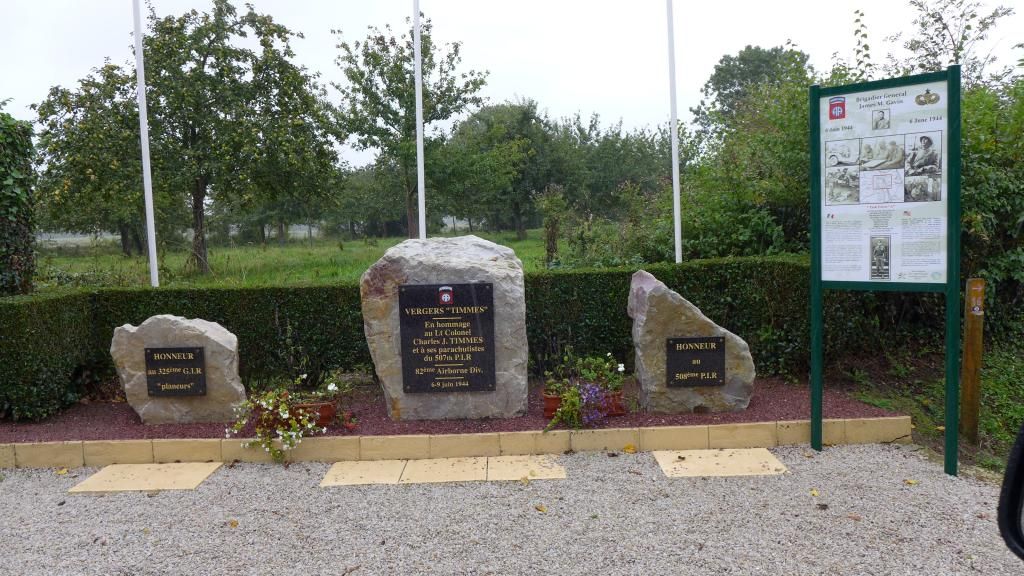

Marmion Farm - E Company 101st Airborne action
Just hours after the D-Day invasion began, James Flanagan, with other paratroopers of the 101st Airborne Division, captured a Nazi flag from a command post headquarters in a farm complex near Ravenoville. The paratroopers had landed in the middle of the night to eliminate German resistance along the causeways to Utah Beach.
Flanagan: Using my clicker [cricket], I started looking for company. At first I didn't recognize my position from the maps that I had previously studied. I heard some shooting, so I began moving toward Ravenoville. The firing was coming from a German MG42 machine gun. The person pulling the trigger, however, wasn't a very good shot. The Army had trained me how to crawl so that I was only 4 inches off the ground, so I did. Soon there was more activity. I began recognizing the sounds of our M-1s. By way of moonlight, using my clicker, I began joining up with troops from other companies and regiments. By dawn, there were about 20 of us. We didn't know each other, but a major [Major John P. Stopka, 3/502nd] came over and organized us into a group and led us on an attack of a German garrison at a farm complex [Marmion] at Ravenoville. This was also the location of the German MG42 that had been firing on us. The Germans were about platoon size in strength. The battle lasted for about an hour and a half…..
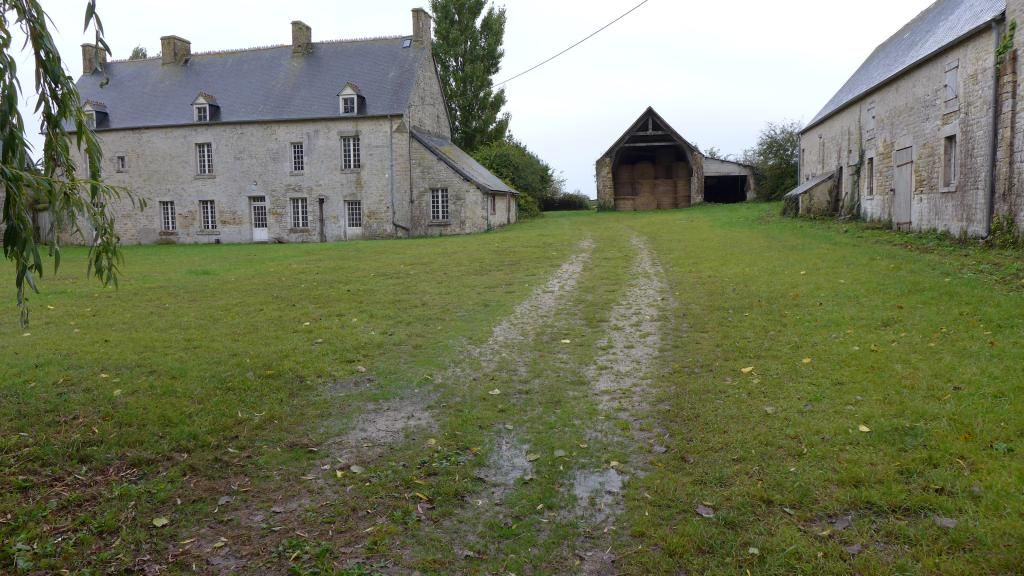
ECompany at the Marmion Farm

Beuzeville au Plein - Lt Thomas Meehan III C47 crash site and monument
Lt Meehan and the 16 members of Easy Company's HQ Section flew to Normandy aboard a C-47 Skytrain of the 439th Troop Carrier Command, one of thirty-six forming Serial 12 of Mission Albany, and was headed for Drop Zone C (1 mile West of Sainte Marie-du-Mont).
The aircraft was hit by German anti-aircraft fire. An eyewitness in another aircraft said "the plane left the formation and slowly initiated a right turn. I followed it with my eyes and noticed its landing lights coming on, I thought it was going to be all right. Then, suddenly, it came crashing down a hedgerow and instantly exploded." The plane crashed near the village of Beuzeville-au-Plain (approximately 2 miles northeast of the town of Sainte-Mère-Église), killing the crew and the paratroopers aboard, including Company "E"'s entire company headquarters group. The wreckage of the plane wasn't confirmed found until the 1950s, so until then, he and all the men on the plane were missing in action. A memorial was later erected near the site.
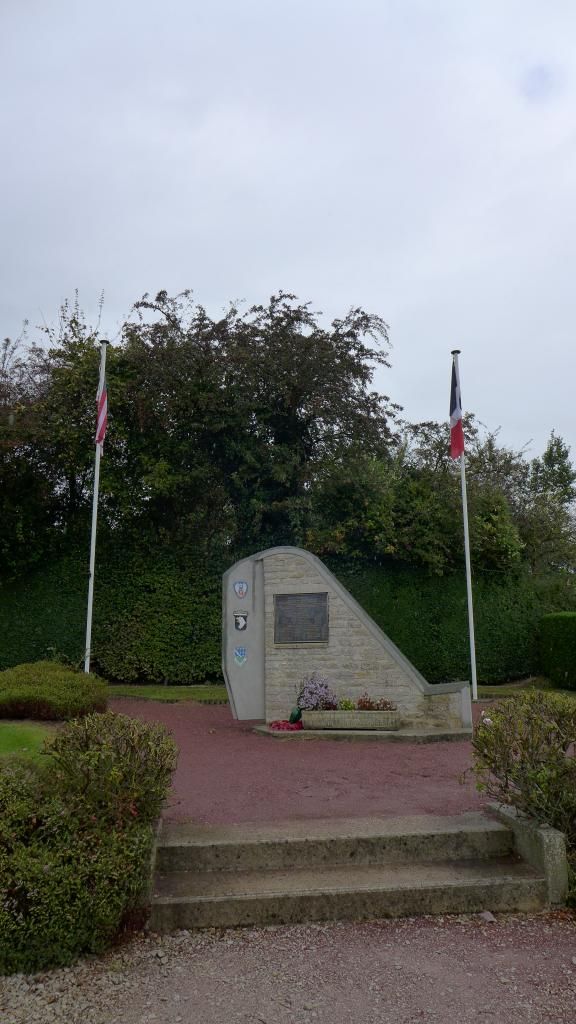
Brecourt Manor - Winters gun emplacement
It may look like just a grassy field but there were four gun emplacements here firing on Utah Beach.

Our guide took about a half an hour to describe how Dick Winters and Ronald Spiers of E Company knocked them out. In all the action of fire and maneuver took about three and a half hours.
Maps and diagrams of the fight
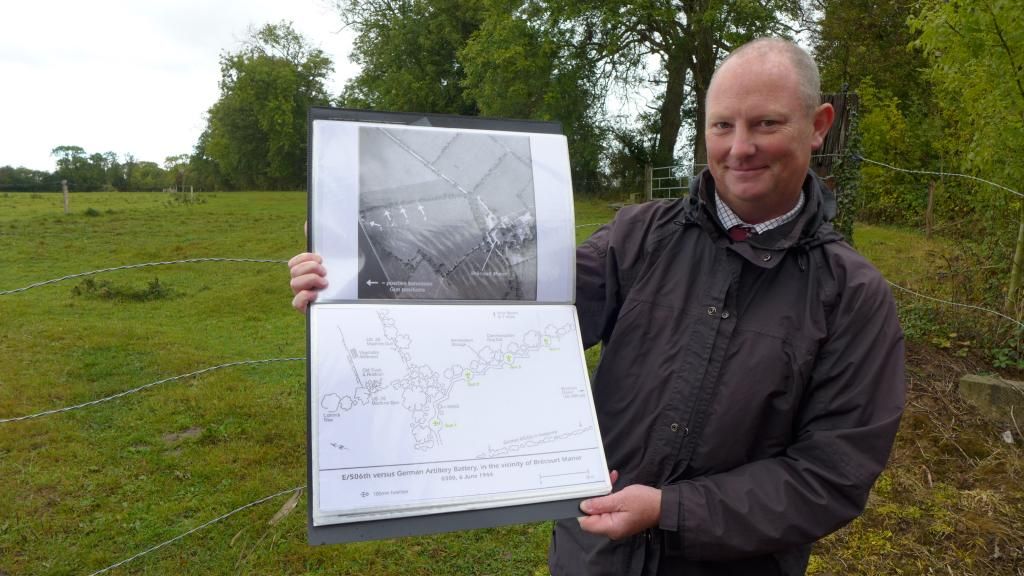
A monument to Winters (within sight of Utah Beach)
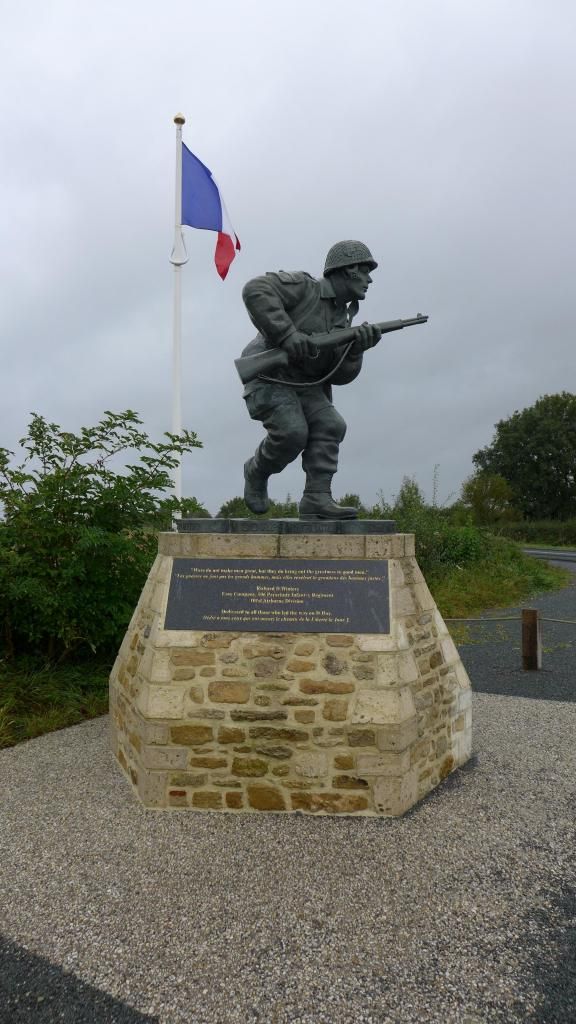
Saint Marie du Mont - Church - Village - Red Ball EXPRESS - 1st village liberated in US sector
During the early hours of June 6th, American paratroopers dropped in behind enemy lines in and around the village, with the objective of securing key targets prior to the allied beach landings. Although elements of the 501st and 506th Airborne were scattered all over the area after the parachute drop, General Taylor regrouped the men and took the Germans by surprise. The village was under allied control in the later that afternoon.
One of the distinguishing features is the tower of the church. This magnificent structure almost seems out of place for such a little village. The bell tower was utilised by the Germans during the war as an observation point. On a clear day, it is possible to see as far as the Bay of Veys.
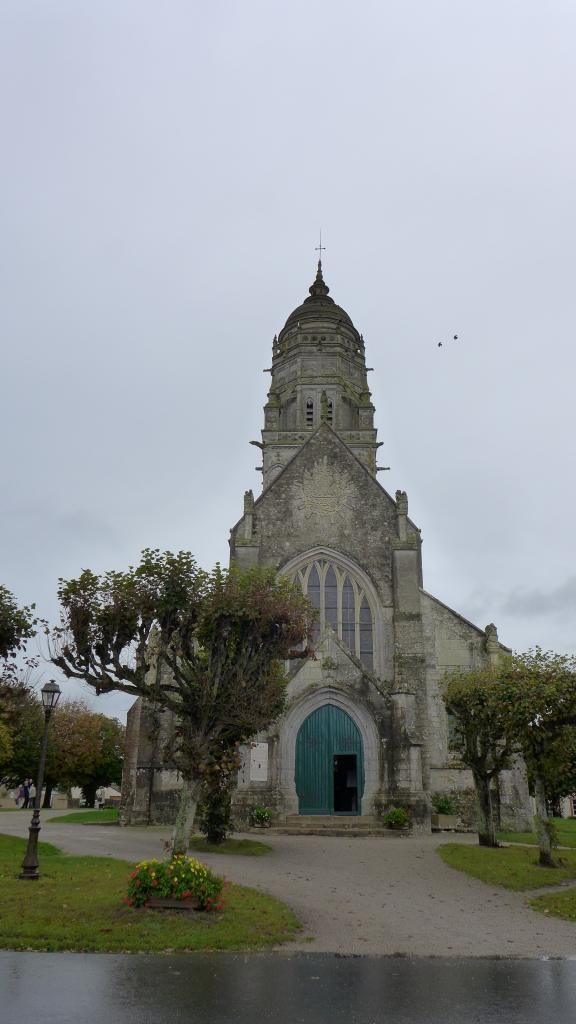
Angoville au Plain - Drop Zone D & 101st A/B 501 PIR Medics Church (Bob Wright & Kenneth Moore) & 506 PIR HQ
Angoville-au-Plain is one of the least populated communes in Manche having only 50-60 inhabitants today, perhaps even fewer in 1944. At 0220 Hrs on June 6, 1944 paratroopers of the 101st Airborne Division landed in their designated DZ (Drop Zone) D, near this small village.
During that afternoon an aid station was set up in the village's 11th century church. Medics, Pvt Robert E. Wright and Pvt Kenneth J. Moore of 2nd Battalion, 501st PIR began caring for wounded US paratroopers. The fighting in the area continued for three days and the number of wounded grew. Casualties from both sides and one French child were treated by Moore and Wright. Angoville changed hands 3 times during the fighting as each side alternatively found it necessary to withdrew and regroup. But the aid station in the church held fast and continued treating the wounded. When the Germans first retook Angoville they burst into the church but when they saw that both American and German wounded were being treated, they placed a red cross on the door and the church was not bothered again.
Both Wright and Moore later received the Silver Star in recognition of their bravery and the 80 lives they saved.
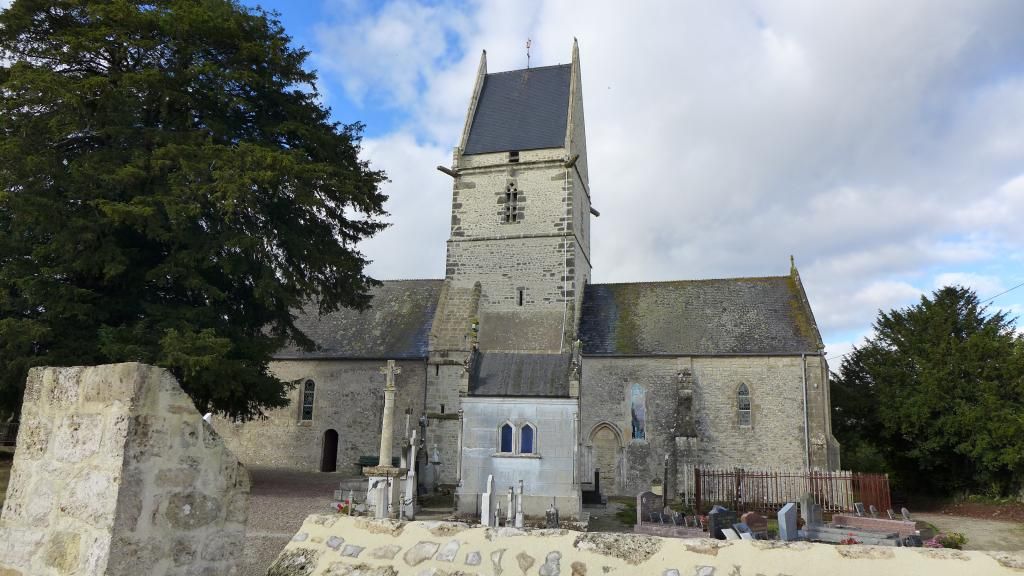
According to our guide, who met and spoke with Bob Wright, Colonel Von der Heydte of the 6th German Parachutist Regiment came in to the church the church where upon Wright admonished him for wearing fire arms in the aide station. Von der Heydte then left his weapons outside the church, came in and asked Wright if he needed anything. Wright said that he and Moore were only medics and that they needed a doctor. Von der Heydte left and shortly thereafter a German doctor arrived and went to work on both the German and American wounded. Later when the church again changed hands the German doctor stayed to take care of the wounded.
Later in the war Von der Heydte was wounded (a broken arm?) and captured. When he went to the aid station he once again met Wright, who took care of his arm, and remembered him from Normandy.
The pews are still stained with blood
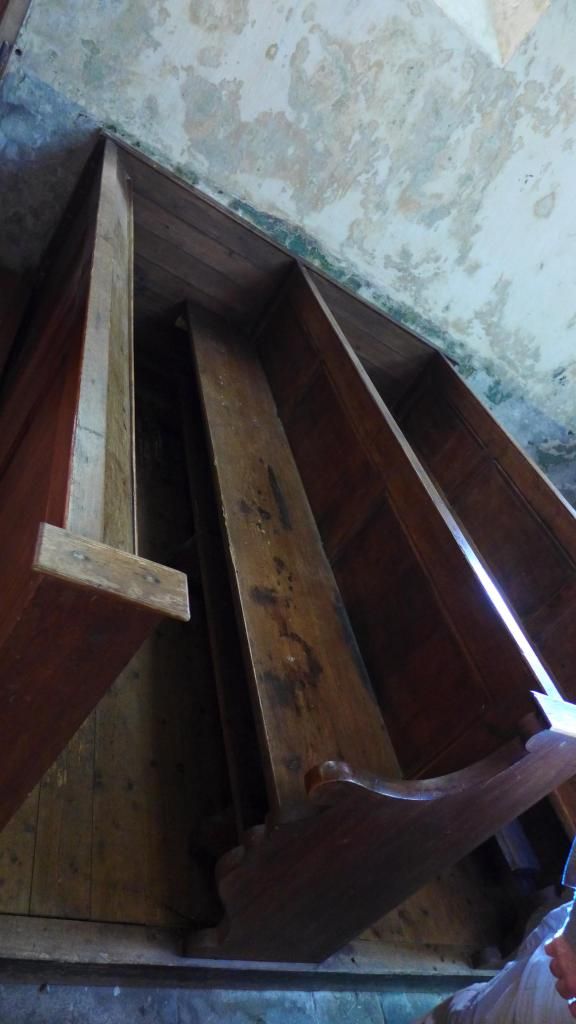
The stained glass windows celebrate the American arrival
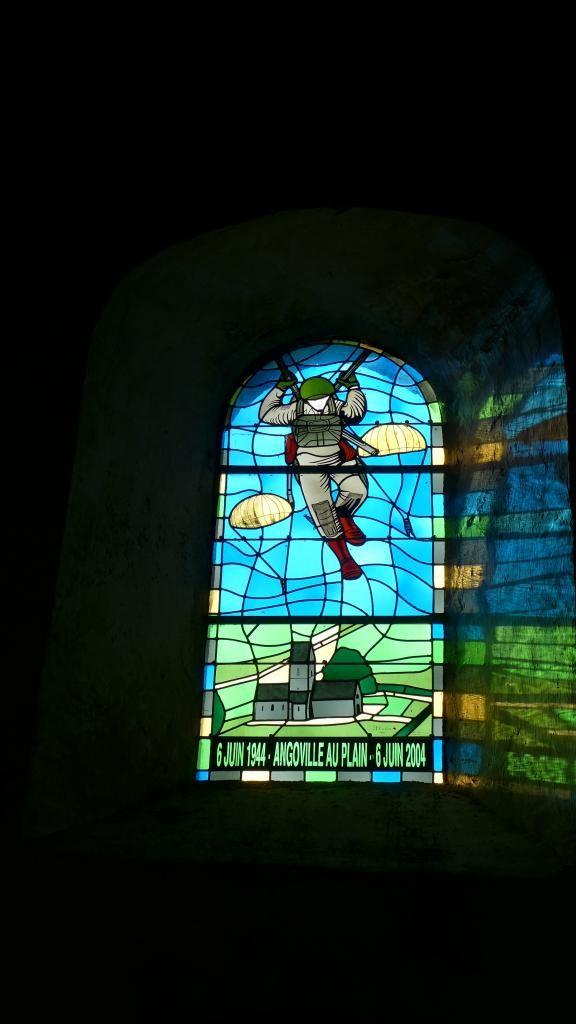
And its use an aid station (the red cross at the top)
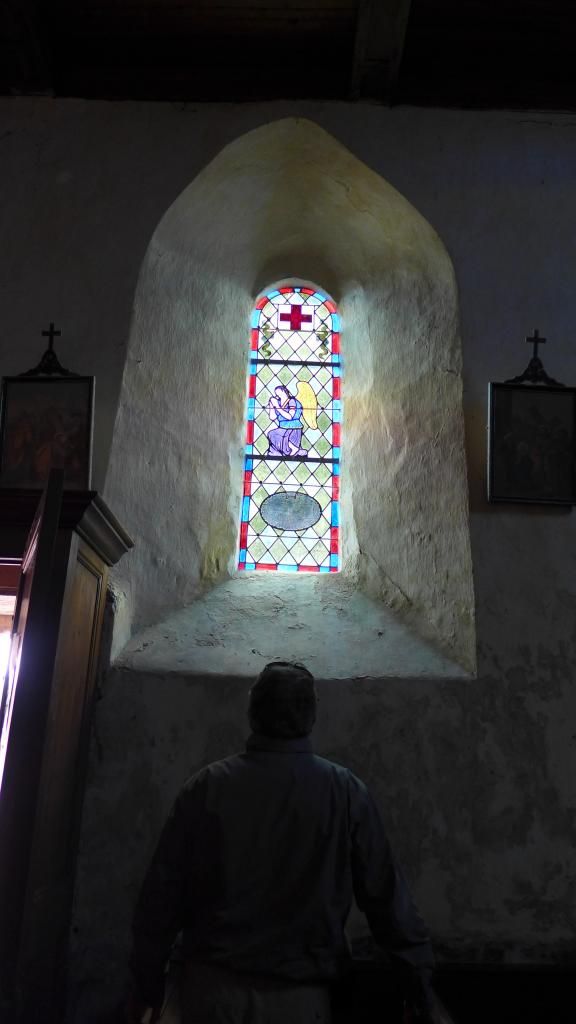
Some observations…
I was surprised at how close everything was such as the American lines were to La Fiere.
That La Fiere was just a group of farm buildings and not a town.
Timmes orchard to the cause way
How close Saint Marie du Mont was to Utah Beach.
And more.
How beautiful the Norman country side is.
How quiet the scenes of carnage and destruction are today.
How, when the tour started, I felt like a tourist on a grand day out and then the church bell at Ste Mere-Eglise began to ring bringing home where I really was and what I was seeing and what had happened here. It really was quite moving. I still get a little misty thinking of it.
And that was just the first of many times. (like walking the causeway to Cauquigny)
Just how thick and impenetrable the bocage really is.
A dirt lane close to Utah Beach with bocage on either side.
(There would be only one way to go and that would be straight down that lane)
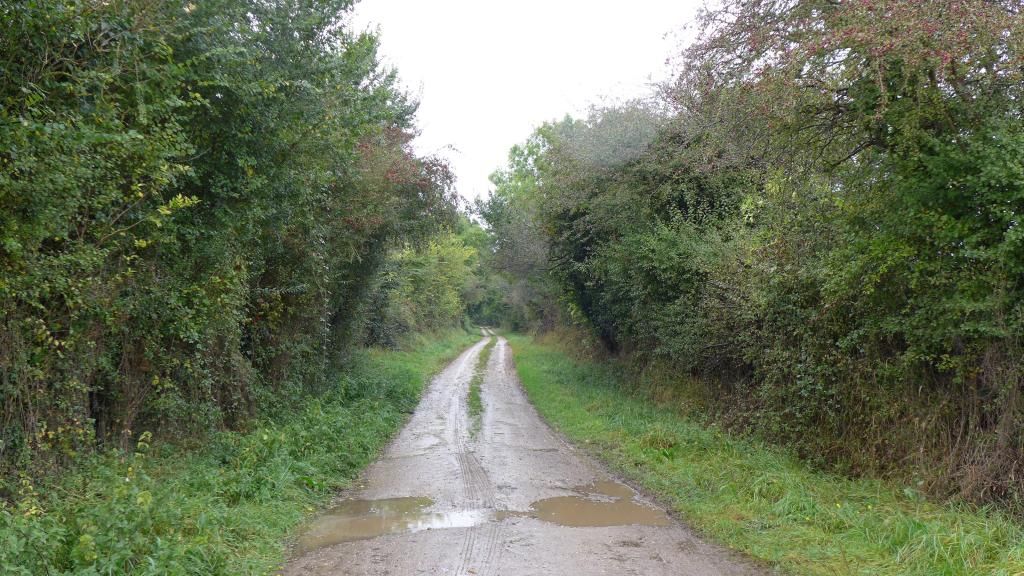
These are from 2014 when my brothers and nephews took a grand six day tour of Normandy.
I see some of the pictures have issues.
I'll fix those at a later date...
I hope you enjoy the tour
Normandy Tour Day 1
We started our tour with the U.S. Airborne sector.
Day 1 - US Airborne Sector
Tour briefing
Ste Mere-Eglise - 82nd A/B 505 PIR
La Fiere - Drop zones T, O, N 82nd A/B
Cauquiny - 325 Glider Infantry Reg - Capt Rae - Church
Cauquiny - DeGlopper Medal of Honor (325 Glider Infantry Reg.)
Amfreville - 82nd Airborne Timmes Orchard
Lunch - Ste Mere-Eglise
Marmion Farm - E Company 101st Airborne action - Forrest Guth - later used by the war correspondents
Foucarville - German POW work camp
Beuzeville au Plein - Lt Thomas Meehan III C47 crash site and monument
Brecourt Manor - Winters gun emplacement - Band of Brothers (E Co 506th PIR 101st Airborne Div)
Major Dick Winters Monument
Saint Marie du Mont - Church - Village - Red Ball EXPRESS - 1st village liberated in US sector
Angoville au Plain - Drop Zone D & 101st A/B 501 PIR Medics Church (Bob Wright & Kenneth Moore) & 506 PIR HQ
Ste Mere Eglise

According to our guide John Steele actually got hooked on the other side of the church, not overlooking the square. His chute lines stretched to where he was alomos touching the ground. Germans who were in the church came out almost immediately, cut the lines and captured him. (He later escaped)
It was the Mayors idea to put the paratrooper on the church overlooking the square after the movie "The Longest Day" came out as a tourist device.
The church itself still shows the scars of the fight but the inside is very beautiful

The stain glass windows celebrate the arrival of the para’s and the liberation that followed.

There's a quiet bridge over the Merderet River some two miles (3km) west of Sainte-Mere-Eglise saw some of the fiercest fighting for the 82nd Airborne Division during their time in Normandy.
The capture of this bridge at La Fiere was considered a pre-requisite to allow Allied forces to cross the Merderet River and push to the eastern side of the Cherbourg peninsula to isolate it for later capture.

The Germans however understood the importance of this position and like at Angoville au Plain, were occupying the position for the Anti-Invasion Exercise that the 92nd German Air-Landing Division was carrying out with the 6th Parachute Regiment on the night of June 5th.
Following an attack by the 505 Regiment in the early hours of June 6th the Germans were pushed out and the bridge then secured. While this was happening, Col Timmes gathered with elements of the 507th Regiment in an orchard just north of the road leading to the la Fiere Bridge on the west bank of the river.
Although out of contact with the Paras on the bridge and completely unsure if the invasion had even succeeded, Col Timmes was occupying strategically important ground over and past which any German counterattack against the positions at the bridge would have to make their way. Although safe from being overrun by the Germans, Col Timmes' mixed Group of Paras was very exposed to German artillery and mortars and suffered heavily during the 3 days they occupied the orchard.
The Germans launched an armoured counter attack on the afternoon of June 6th but were beaten back by the combined efforts of both groups of paratroopers. A second armoured attack on June 7th was also beaten off but by this stage the Paras were starting to ask; Where are the tanks? They had been told that the tanks coming inland from Utah Beach would be with them by lunch time of June 6th. Finally on the evening of June 7th support arrived but still no American tanks and the Paras spent most of June 8th still fighting off counter attacks.
On June 9th the tanks finally arrived and were ready to advance across the causeway, finally securing the position and also carrying relief to the other two 82 Airborne Regiments that were isolated on the other side of the river Merderet.
There's a monument to the airborne overlooking the causeway towards Coquiney.

The farm complex, bridge and causeway at La Fiere.
You can see the Coquiney chaple in the distance.
http://www.travelfranceonline.com/la-fiere-memorial-park-and-battle-wwii/


Unfortunately it was pouring rain at the time and could take few photos.
Monument to Col. Timmes and the Para's at Timmes Orchard


Marmion Farm - E Company 101st Airborne action
Just hours after the D-Day invasion began, James Flanagan, with other paratroopers of the 101st Airborne Division, captured a Nazi flag from a command post headquarters in a farm complex near Ravenoville. The paratroopers had landed in the middle of the night to eliminate German resistance along the causeways to Utah Beach.
Flanagan: Using my clicker [cricket], I started looking for company. At first I didn't recognize my position from the maps that I had previously studied. I heard some shooting, so I began moving toward Ravenoville. The firing was coming from a German MG42 machine gun. The person pulling the trigger, however, wasn't a very good shot. The Army had trained me how to crawl so that I was only 4 inches off the ground, so I did. Soon there was more activity. I began recognizing the sounds of our M-1s. By way of moonlight, using my clicker, I began joining up with troops from other companies and regiments. By dawn, there were about 20 of us. We didn't know each other, but a major [Major John P. Stopka, 3/502nd] came over and organized us into a group and led us on an attack of a German garrison at a farm complex [Marmion] at Ravenoville. This was also the location of the German MG42 that had been firing on us. The Germans were about platoon size in strength. The battle lasted for about an hour and a half…..

ECompany at the Marmion Farm

Beuzeville au Plein - Lt Thomas Meehan III C47 crash site and monument
Lt Meehan and the 16 members of Easy Company's HQ Section flew to Normandy aboard a C-47 Skytrain of the 439th Troop Carrier Command, one of thirty-six forming Serial 12 of Mission Albany, and was headed for Drop Zone C (1 mile West of Sainte Marie-du-Mont).
The aircraft was hit by German anti-aircraft fire. An eyewitness in another aircraft said "the plane left the formation and slowly initiated a right turn. I followed it with my eyes and noticed its landing lights coming on, I thought it was going to be all right. Then, suddenly, it came crashing down a hedgerow and instantly exploded." The plane crashed near the village of Beuzeville-au-Plain (approximately 2 miles northeast of the town of Sainte-Mère-Église), killing the crew and the paratroopers aboard, including Company "E"'s entire company headquarters group. The wreckage of the plane wasn't confirmed found until the 1950s, so until then, he and all the men on the plane were missing in action. A memorial was later erected near the site.

Brecourt Manor - Winters gun emplacement
It may look like just a grassy field but there were four gun emplacements here firing on Utah Beach.

Our guide took about a half an hour to describe how Dick Winters and Ronald Spiers of E Company knocked them out. In all the action of fire and maneuver took about three and a half hours.
Maps and diagrams of the fight

A monument to Winters (within sight of Utah Beach)

Saint Marie du Mont - Church - Village - Red Ball EXPRESS - 1st village liberated in US sector
During the early hours of June 6th, American paratroopers dropped in behind enemy lines in and around the village, with the objective of securing key targets prior to the allied beach landings. Although elements of the 501st and 506th Airborne were scattered all over the area after the parachute drop, General Taylor regrouped the men and took the Germans by surprise. The village was under allied control in the later that afternoon.
One of the distinguishing features is the tower of the church. This magnificent structure almost seems out of place for such a little village. The bell tower was utilised by the Germans during the war as an observation point. On a clear day, it is possible to see as far as the Bay of Veys.

Angoville au Plain - Drop Zone D & 101st A/B 501 PIR Medics Church (Bob Wright & Kenneth Moore) & 506 PIR HQ
Angoville-au-Plain is one of the least populated communes in Manche having only 50-60 inhabitants today, perhaps even fewer in 1944. At 0220 Hrs on June 6, 1944 paratroopers of the 101st Airborne Division landed in their designated DZ (Drop Zone) D, near this small village.
During that afternoon an aid station was set up in the village's 11th century church. Medics, Pvt Robert E. Wright and Pvt Kenneth J. Moore of 2nd Battalion, 501st PIR began caring for wounded US paratroopers. The fighting in the area continued for three days and the number of wounded grew. Casualties from both sides and one French child were treated by Moore and Wright. Angoville changed hands 3 times during the fighting as each side alternatively found it necessary to withdrew and regroup. But the aid station in the church held fast and continued treating the wounded. When the Germans first retook Angoville they burst into the church but when they saw that both American and German wounded were being treated, they placed a red cross on the door and the church was not bothered again.
Both Wright and Moore later received the Silver Star in recognition of their bravery and the 80 lives they saved.

According to our guide, who met and spoke with Bob Wright, Colonel Von der Heydte of the 6th German Parachutist Regiment came in to the church the church where upon Wright admonished him for wearing fire arms in the aide station. Von der Heydte then left his weapons outside the church, came in and asked Wright if he needed anything. Wright said that he and Moore were only medics and that they needed a doctor. Von der Heydte left and shortly thereafter a German doctor arrived and went to work on both the German and American wounded. Later when the church again changed hands the German doctor stayed to take care of the wounded.
Later in the war Von der Heydte was wounded (a broken arm?) and captured. When he went to the aid station he once again met Wright, who took care of his arm, and remembered him from Normandy.
The pews are still stained with blood

The stained glass windows celebrate the American arrival

And its use an aid station (the red cross at the top)

Some observations…
I was surprised at how close everything was such as the American lines were to La Fiere.
That La Fiere was just a group of farm buildings and not a town.
Timmes orchard to the cause way
How close Saint Marie du Mont was to Utah Beach.
And more.
How beautiful the Norman country side is.
How quiet the scenes of carnage and destruction are today.
How, when the tour started, I felt like a tourist on a grand day out and then the church bell at Ste Mere-Eglise began to ring bringing home where I really was and what I was seeing and what had happened here. It really was quite moving. I still get a little misty thinking of it.
And that was just the first of many times. (like walking the causeway to Cauquigny)
Just how thick and impenetrable the bocage really is.
A dirt lane close to Utah Beach with bocage on either side.
(There would be only one way to go and that would be straight down that lane)

Last edited:










































































































